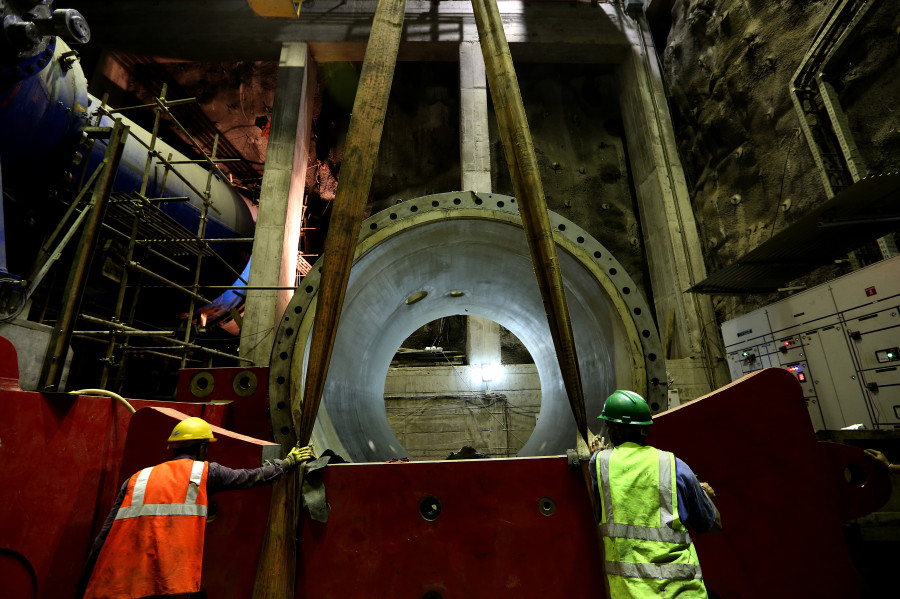Money
Upper Tamakoshi project makes progress on penstock installation
Construction work on the 456 megawatt run-of-the-river scheme began in 2012.
Prahlad Rijal
The installation of penstock pipes in the lower vertical shaft of the Upper Tamakoshi hydro project is progressing faster after suffering multiple setbacks owing to equipment breakdown and technical mishaps.
The Rs73-billion scheme, which faced scrutiny by domestic lenders and Energy Ministry and power utility officials over the past months, reported 20 percent progress in penstock installation, four months after work started. Last month, progress was recorded at 10 percent.
"We have fixed more than 80 metres of pipe in the 372-metre vertical tunnel," said project chief Bigyan Shrestha, "A crew comprising European and Indian engineers and site workers will carry on with the installation during the festival season. The contractors have added crew members to offset the impact of the absence of Nepali workers."
The Upper Tamakoshi Hydroelectric Project located in Dolakha is Nepal's largest under-construction hydropower plant. Construction work on the 456 megawatt run-of-the-river scheme began in 2012.
Fitting the pipes in the lower shaft is considered to be the most challenging part of the hydro-mechanical component of the project. Work crews have to rope, crane down and fix 74 pipe sections, each weighing 27 tonnes, in the vertical shaft, through which water will be conveyed at high speed into the turbines.
"At present, 16 of the pipes are in place and have been fixed, while work has been expedited at the upper tunnel," said Shrestha. However, at the current pace of installation, they are likely to miss the February 2020 completion deadline.
Five months remain for the revised deadline to expire; and at the rate of four pipes a month, it will take more than 14 months to fit the rest of the pipes.
Project officials say otherwise. “We have witnessed 10 percent progress in the last month; and work will move faster in the coming days as less time will be needed to fit the pipes in the upper part of the tunnel,” said Shrestha. “Installing the first 20 pipe sections consumed a lot of time owing to the need for precision.”
Last year, after Texmaco, the Indian contractor assigned to implement the hydro-mechanical component, admitted that installing the massive pipes was beyond its scope, the Nepal Electricity Authority brought in Austrian company Andritz Hydro to execute the task.
The Austrian contractor also suffered a setback due to crane failure. Work at the site resumed in June after a six-month break.
While the powerhouse and the dam are ready to be commissioned, officials say the project is incurring losses amounting to Rs40 million in interest expenses and power sales per day following delays in fitting the penstock pipes.
The domestically financed and role model scheme has encountered funding gaps and cost escalations, drawing criticism from stakeholders.
In June, the project urged the major lenders—Nepal Telecom, Citizen Investment Trust, Rastriya Beema Sansthan and Employees Provident Fund—to inject another Rs7 billion into the project.
Over the years, the project's price tag has swelled to Rs73 billion, including interest on loans, from the initial cost estimate of Rs49 billion. Interest payments on long-term loans alone have jumped from Rs6.7 billion in 2016 to Rs14.42 billion in two years, and are expected to rise further.
A weakening Nepali rupee against the dollar and the euro is expected to push up the bill further.
“Although the project is being built with equity and debt in Nepali currency, the agreement with the contractors for all four major components requires the company to release payment in dollars and euros by absorbing currency fluctuation risks,” said the project office.
The Upper Tamakoshi Hydroelectric Project is touted to be of high economic importance to Nepal as it will not only make it an energy surplus country, but also cut the import of electricity from India in the dry season, thus saving billions.
As per the power utility’s preliminary annual statistics, the country paid over Rs22 billion for imported electricity in the last fiscal year.




 7.12°C Kathmandu
7.12°C Kathmandu














